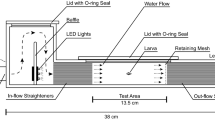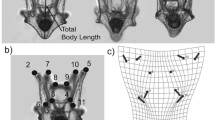Abstract
The extent to which behaviour affects the dispersal of pelagic larvae in reef fishes has been a topic of major discussion among marine ecologists. Here, we experimentally quantified the extent to which the displacement of late-stage larvae of Abudefduf saxatilis is due to active movement (i.e. swimming) and drifting. We consider drifting as the component of larval displacement accounted for by the current. Drifting was quantified by comparing larval displacement to the displacement of passive particles in an extended flow chamber that gave larvae the free choice of swimming (i.e. swim with or against the current or not swim at all). We also determine whether drifting results from currents exceeding larval swimming capabilities or from the behavioural choice of larvae of not to swim against adverse currents. To do this, we compare the speeds of larval swimming in the extended flow chamber to those obtained in a smaller chamber in which larvae are behaviourally forced to swim due to space constraints and a retaining fence (most available data on larval swimming is based on this sort of chamber). Within the extended chamber, larvae tended to face the current and swim slower than it. This resulted in a net displacement increasingly determined by drifting. We also found that in the extended chamber, larvae swam at speeds between one and six times slower than the speeds they achieved in the “behaviourally modifying” smaller chamber. This suggests that the net displacement in the extended chamber was in part due to the behavioural choice of the larvae of not to swim. The importance of this “behavioural drifting” is discussed in terms of energy savings required for successful completion of the larval period and post-settlement survival. The idea that larvae may modulate their swimming behaviour raises caution for the use of published data regarding swimming capabilities of reef fish larvae when assessing the extent to which these fish actively affect their dispersal.




Similar content being viewed by others
References
Armsworth PR, James MK, Bode L (2001) When to press on or turn back: dispersal strategies for reef fish larvae. Am Nat 157:434–450
Atema J, Kingsford MJ, Gerlach G (2002) Larval reef fish could use odour for detection, retention and orientation to reefs. Mar Ecol Prog Ser 241:151–160
Bellwood DR, Fisher R (2001) Relative swimming speeds in reef fish larvae. Mar Ecol Prog Ser 211:299–303
Bellwood DR, Leis JM, Stobutzki IC (1998) Fishery and reef management. Science 279:2019–2025
Bergenius MAJ, Meekan MG, Robertson DR, McCormick MI (2002) Larval growth predicts the recruitment success of a coral reef fish. Oecologia 131:521–525
Bernatchez L, Dodson JJ (1987) Relationship between bioenergetics and behaviour in anadromous fish migrations. Can J Fish Aquat Sci 44:399–407
Bishai HM (1960) The effect of water currents on the survival and distribution of fish larvae. J Cons Perm Int Explor Mer 25:134–146
Brett JR (1964) The respiratory metabolism and swimming performance of young sockeye salmon. J Fish Res Board Can 21:1183–1226
Colin PL (2003) Larvae retention: genes or oceanography? Science 300:1657
Cowen RK, (2002) Larval dispersal and retention and consequences for population connectivity. In: Sale PF (ed) Coral reef fishes: dynamics and diversity in a complex ecosystem. Academic, San Diego, pp 149–170
Dodson JJ (1997) Fish migration: an evolutionary perspective. In: Godin J-GJ (ed) Behavioural ecology of teleost fishes. Oxford University Press, Oxford, pp 10–36
Fisher R, Bellwood DR (2000) Development of swimming abilities in reef fish larvae. Mar Ecol Prog Ser 163:163–173
Fisher R, Bellwood DR (2001) Effects of feeding on the sustained swimming abilities of the late-stage larval Amphiprion melanopus. Coral Reefs 20:151–154
Fisher R, Bellwood DR (2002) The influence of swimming speed on sustained swimming performance of late-stage reef fish larvae. Mar Biol 140:801–807
Fisher R, Bellwood DR (2003) Undisturbed swimming behaviour and nocturnal activity of coral reef fish larvae. Mar Ecol Prog Ser 263:177–188
Hindell JS, Jenkins GP, Moran SM, Keough MJ (2003) Swimming ability and behaviour of post-larvae of a temperate marine fish re-entrained in the pelagic environment. Oecologia 135:158–166
Humann P, Deloach N (2002) Reef fish identification: Florida-Caribbean-Bahamas. New World Publications, Jacksonville
Kingsford MJ, Leis JM, Shanks A, Lindeman KC, Morgan SG, Pineda J (2002) Sensory environments, larval abilities and local self-recruitment. Bull Mar Sci 70:309–340
Leis JM (2002) Pacific coral-reef fishes: the implications of behaviour and ecology of larvae for biodiversity and conservation, and a reassessment of the open population paradigm. Environ Biol Fish 65:199–208
Leis JM, Carson-Ewart BM (1997) In situ swimming speeds of the late pelagic larvae of some Indo-pacific coral-reef fishes. Mar Ecol Prog Ser 159:165–174
Leis JM, McCormick MI (2002) The biology, behaviour, and ecology of the pelagic, larval stage of coral reef fishes. In: Sale PF (ed) Coral reef fishes: dynamics and diversity in a complex ecosystem. Academic, San Diego, pp 171–199
Leis JM, Miller JM (1976) Offshore distributional patterns of Hawaiian fish larvae. Mar Biol 36:359–367
Leis JM, Stobutzki IC (1999) Swimming performance of late pelagic larvae of coral-reef fishes: in situ and laboratory-based measurements. In: Séret B, Sire J-Y (eds) Proceedings of 5th Indo-pacific Fish Conference, Noumea, 1997, pp 575–583
Leis JM, Carson-Ewart BM, Cato DH (2002) Sound detection in situ by the larvae of a coral-reef damselfish (Pomacentridae). Mar Ecol Prog Ser 232:259–268
McCormick MI (1998) Condition and growth of reef fishes at settlement: is it important? Aust J Ecol 23:258–264
McHenry MJ, Azizi E, Strother JA (2003) The hydrodynamics of locomotion at intermediate Reynolds numbers: undulatory swimming in ascidian larvae (Botryllloides sp.). J Exp Biol 206:327–343
Mora C, Sale PF (2002) Are populations of coral reef fish open or closed? Trends Ecol Evol 17:422–428
Mora C, Chittaro PM, Sale PF, Kritzer JP, Ludsin SA (2003) Patterns and processes in reef fish diversity. Nature 421:933–936
Morgan SG (2001) The larval ecology of marine communities. In: Bertness MD, Gaines SD, Hay ME (eds) Marine community ecology. Sinauer Associates Inc., Sunderland, pp 159–181
Pankhurst NW, Sharples DF (1992) Effects of capture and confinement on plasma cortisol levels in the snapper Pagrus auratus. Aust J Mar Freshwat Res 43:334–346
Planes S (2002) Biogeography and larval dispersal inferred from population genetic analysis. In: Sale PF (ed) Coral reef fishes: dynamics and diversity in a complex ecosystem. Academic, San Diego, pp 201–220
Roberts CM (1997) Connectivity and management of Caribbean coral reefs. Science 278:1280–1284
Roberts CM (1998) Fishery and reef management. Science 279:2019–2025
Sale PF (1970) Distribution of larval Acanthuridae of Hawaii. Copeia 1970:765–766
Sale PF, Cowen RK (1998) Fishery and reef management. Science 279:2019–2025
Shulman MJ (1998) What can population genetics tell us about dispersal and biogeographic history of coral-reef fishes. Aust J Ecol 23:216–225
Stobutzki IC (1997) Energetic cost of sustained swimming in the late pelagic stages of reef fishes. Mar Ecol Prog Ser 152:249–259
Stobutzki IC (1998) Interspecific variation in sustained swimming ability of late pelagic stage reef fish from two families (Pomacentridae and Chaetodontidae). Coral Reefs 17:111–119
Stobutzki IC (2000) Marine reserves and the complexity of larval dispersal. Rev Fish Biol Fish 10:515–518
Stobutzki IC, Bellwood DR (1994) An analysis of the sustained swimming abilities of pre- and post-settlement coral reef fishes. J Exp Mar Biol Ecol 175:275–286
Stobutzki IC, Bellwood DR (1997) Sustained swimming abilities of the late pelagic stages of coral reef fishes. Mar Ecol Prog Ser 149:35–41
Taylor MS, Hellberg ME (2003) Genetic evidence for local retention of pelagic larvae in a Caribbean reef fish. Science 299:107–109
Tolimieri N, Jeffs A, Montgomery JC (2000) Ambient sound as a cue for navigation by the pelagic larvae of reef fishes. Mar Ecol Prog Ser 207:219–224
Underwood AJ, Keough MJ (2001) Supply-side ecology: the nature and consequences of variations in recruitment of intertidal organisms. In: Bertness MD, Gaines SD, Hay ME (eds) Marine community ecology. Sinauer Associates Inc., Sunderland, pp 183–200
Warner RR, Cowen RK (2002) Local retention of production in marine populations: evidence, mechanisms, and consequences. Bull Mar Sci 70:245–249
Warner RR, Palumbi SR (2003) Response to: genetic evidence for local retention of pelagic larvae in a Caribbean reef fish. Science 300:1685
Webb PW (1993) Swimming. In: Evans DD (ed) The physiology of fishes. CRC Press, Boca Raton, pp 47–73
Wellington GM, Victor BC (1989) Planktonic larval duration of one hundred species of Pacific and Atlantic damselfishes (Pomacentridae). Mar Biol 101:557–567
Wolanski E, Doherty P, Carelton J (1997) Directional swimming of reef fish larvae determines connectivity of fish populations on the Great Barrier Reef. Naturwissenschaften 84:262–268
Acknowledgements
We thank E. Garcia, C. Nolan and all the staff at the Institute for Marine Studies (University of Belize, Belize) for field support. M. Enns and S. Budinsky for construction of the small swimming chamber. P.F. Sale, J. P. Kritzer, P. M. Chittaro and S. Bartnik provided helpful comments on this manuscript. This project was funded by NSERC CRO grant# 227965 awarded to P. F. Sale and an Ontario Graduate Scholarship awarded to C. M. These experiments complied with the current laws of Belize.
Author information
Authors and Affiliations
Corresponding author
Additional information
Communicated by P. W. Sammarco, Chauvin
Rights and permissions
About this article
Cite this article
Derek Hogan, J., Mora, C. Experimental analysis of the contribution of swimming and drifting to the displacement of reef fish larvae. Marine Biology 147, 1213–1220 (2005). https://doi.org/10.1007/s00227-005-0006-5
Received:
Accepted:
Published:
Issue Date:
DOI: https://doi.org/10.1007/s00227-005-0006-5




